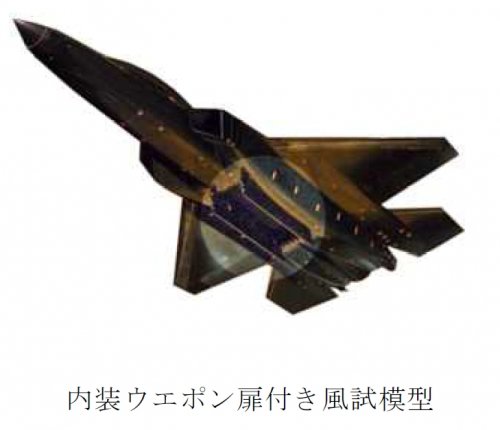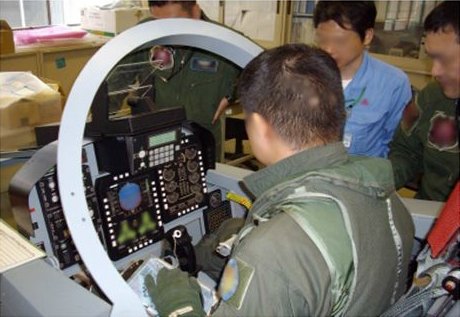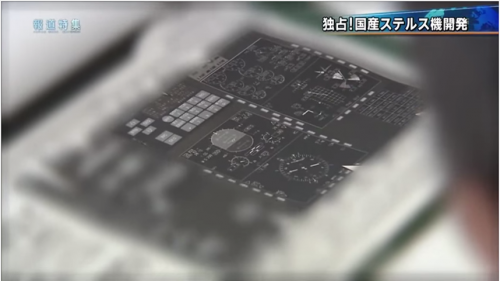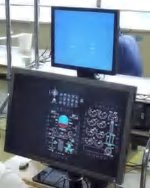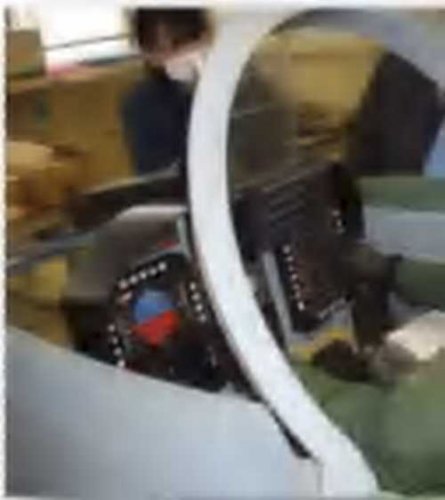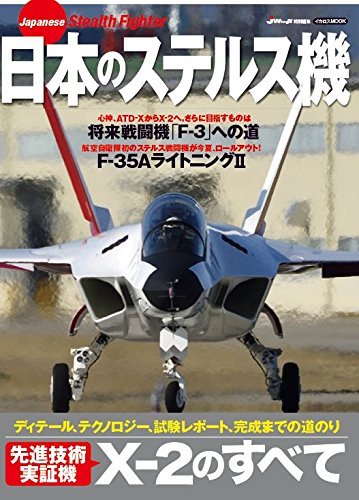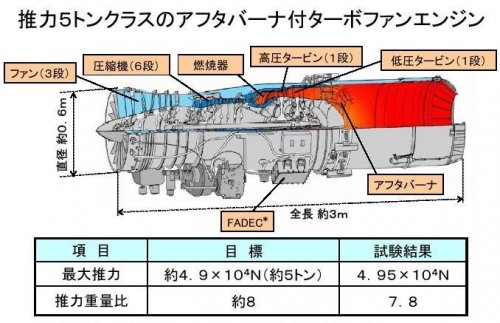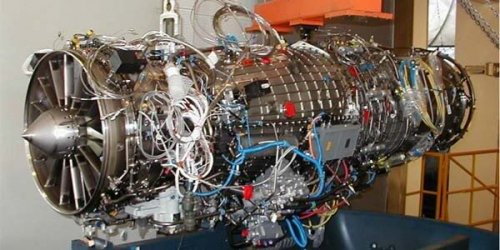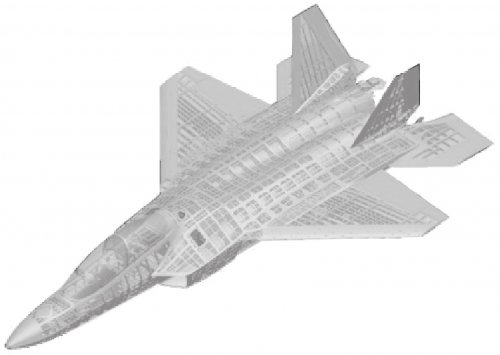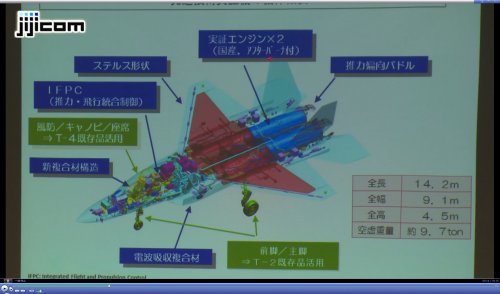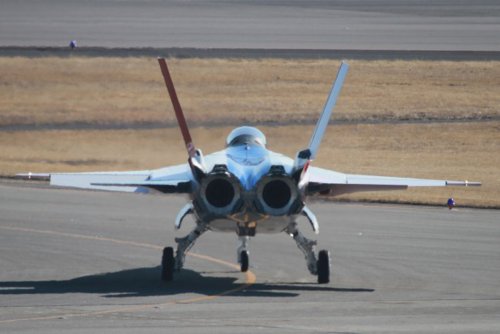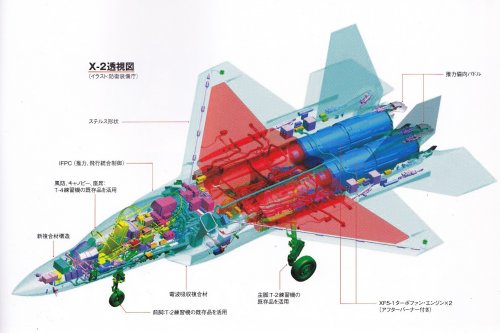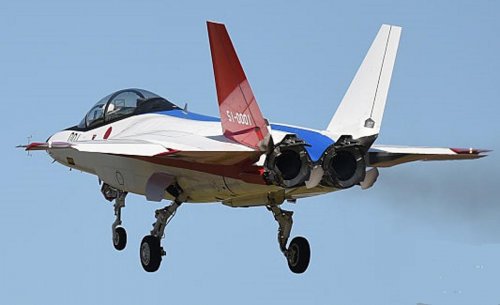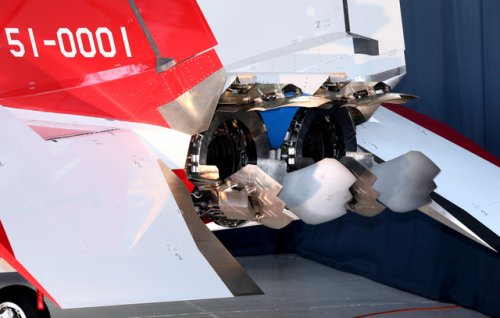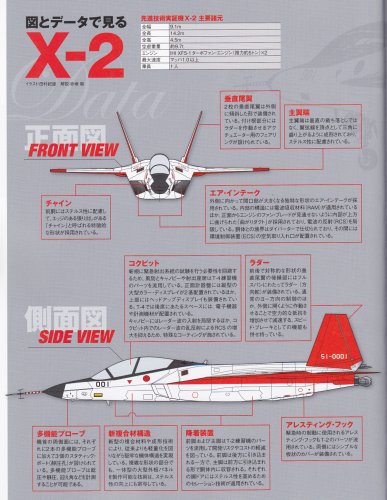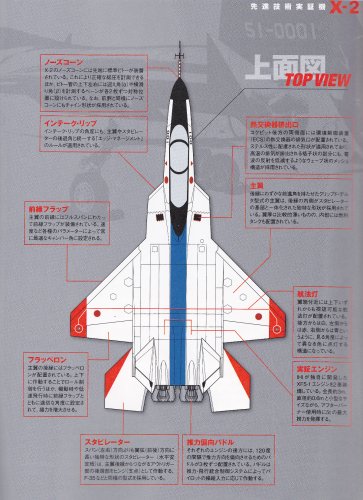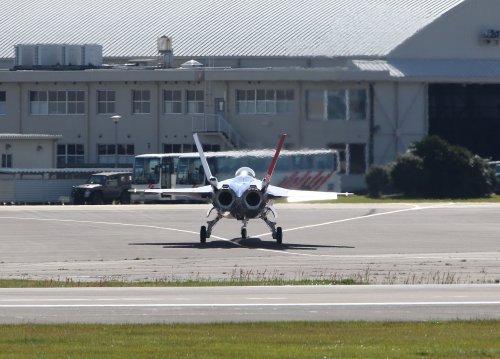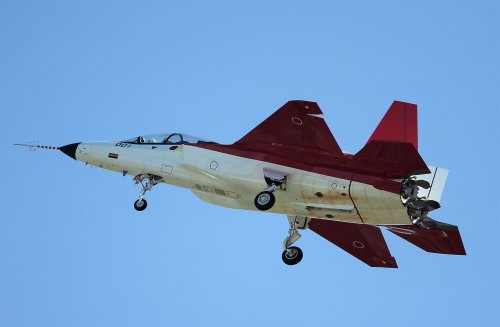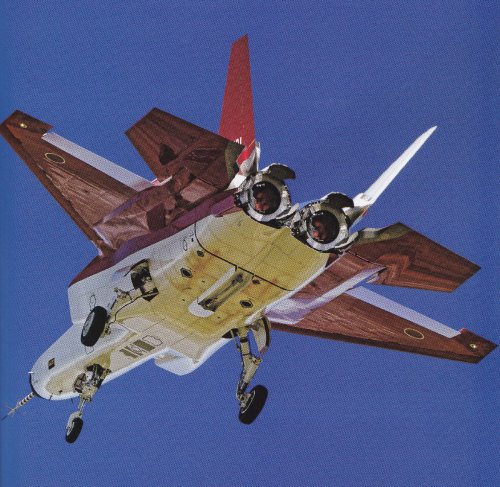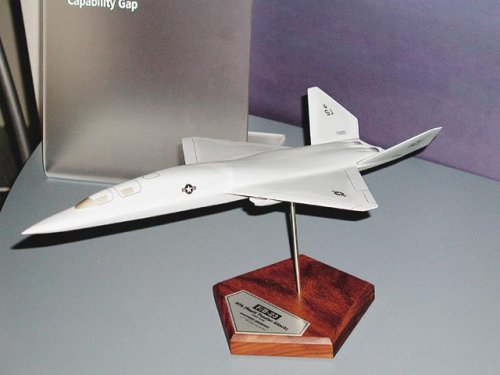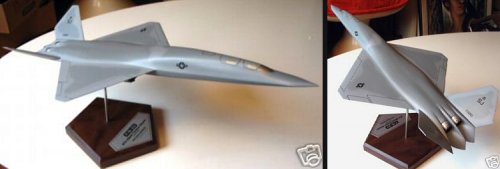You are using an out of date browser. It may not display this or other websites correctly.
You should upgrade or use an alternative browser.
You should upgrade or use an alternative browser.
Mitsubishi X-2 ATD-X Shinshin Demonstrator
- Thread starter Sentinel Chicken
- Start date
blackkite
Don't laugh, don't cry, don't even curse, but.....
- Joined
- 31 May 2007
- Messages
- 8,819
- Reaction score
- 7,718
I can't find any answer about this question in Japanese internet site.flateric said:Anybody knows if structural tests were carried using X-2 flight airframe, or a second one was built for this purpose?
- Joined
- 1 April 2006
- Messages
- 11,397
- Reaction score
- 10,309
http://www.asdnews.com/news-41758/MHI_Begins_Assembly_of_Full-scale_Model_for_ATD_Aircraft_Project.htm
MHI Begins Assembly of Full-scale Model for ATD Aircraft Project
Wed, Mar 28, 2012 2:25 PM
Mitsubishi Heavy Industries, Ltd. (MHI) today began assembly of a full-scale structural-testing model of an Advanced Technology Demonstrator (ATD). The ATD, which MHI is building under the contract with the Japan Ministry of Defense, will be used to prove the airworthiness of advanced technologies, including stealth capabilities and high maneuverability, for future Japanese fighters. With the commencement of assembly, the ATD project has now moved into the production phase.
To mark the beginning of assembly work, the "first rivet" ceremony was held earlier today at the Tobishima Plant of MHI's Nagoya Aerospace Systems Works in Aichi Prefecture. Among those attendees were Yoshitaka Akiyama, Director General of the Technical Research & Development Institute, the Japan Ministry of Defense; Haruhiko Kataoka, Japan Air Self-Defense Force Chief of Staff; and Takashi Kobayashi, Representative Director, Executive Vice President and Head of MHI's Aerospace Systems.
During the ceremony, an equipment mounting bracket was riveted to the bulkhead separating the fuel tank from the forward equipment bay in the mid fuselage, which houses electronic equipments. It marks the first step in the assembly of the ATD aircraft. This riveting was conducted for the full-scale static structural test model to be used to obtain strength data of the aircraft’s basic structural elements and to verify the design of the ATD.
blackkite
Don't laugh, don't cry, don't even curse, but.....
- Joined
- 31 May 2007
- Messages
- 8,819
- Reaction score
- 7,718
Hi!
Mitsubishi X-2 engine air intake boundary layer outlet device which located upper side of the fuselage just behind the cockpit is almost same as F-22's one.
Mitsubishi X-2 engine air intake boundary layer outlet device which located upper side of the fuselage just behind the cockpit is almost same as F-22's one.
Attachments
-
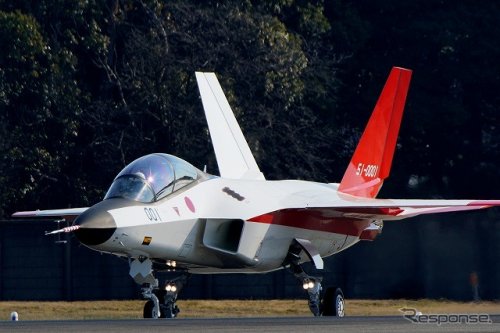 1040293.jpg89.1 KB · Views: 193
1040293.jpg89.1 KB · Views: 193 -
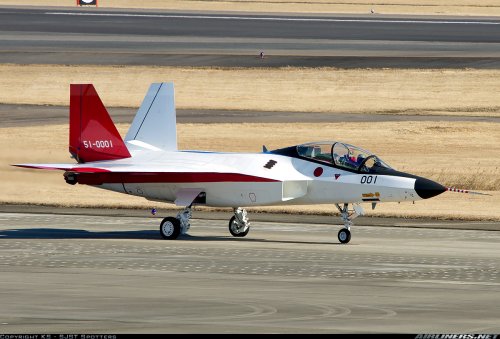 2777992.jpg436.9 KB · Views: 157
2777992.jpg436.9 KB · Views: 157 -
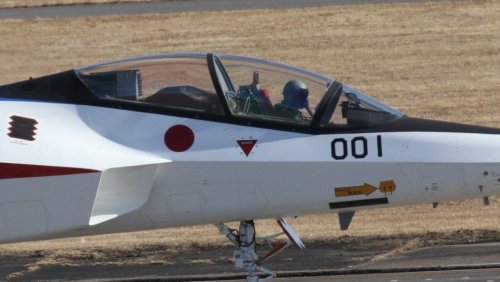 960x960.jpg121.2 KB · Views: 148
960x960.jpg121.2 KB · Views: 148 -
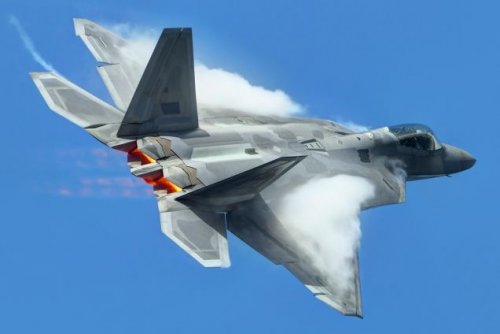 1455603512_f-22-raptor_1.jpg24.6 KB · Views: 161
1455603512_f-22-raptor_1.jpg24.6 KB · Views: 161 -
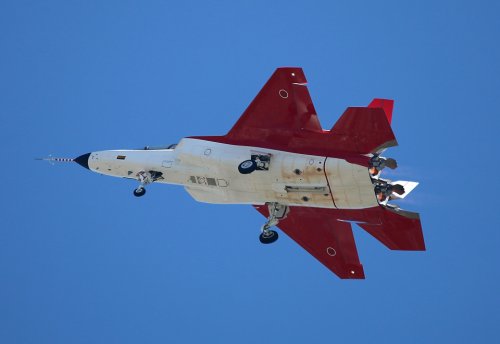 7.jpg131.7 KB · Views: 189
7.jpg131.7 KB · Views: 189 -
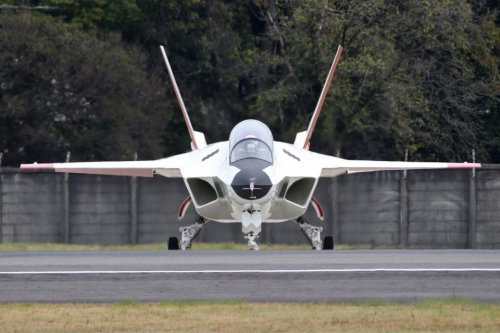 6.jpg75.7 KB · Views: 826
6.jpg75.7 KB · Views: 826 -
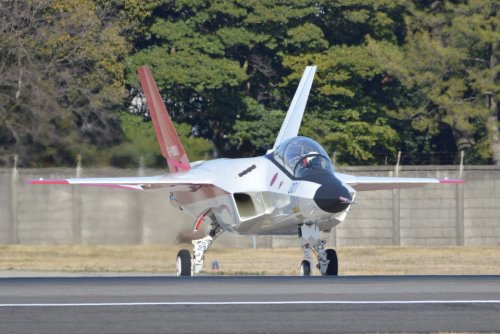 5.jpg164.5 KB · Views: 844
5.jpg164.5 KB · Views: 844 -
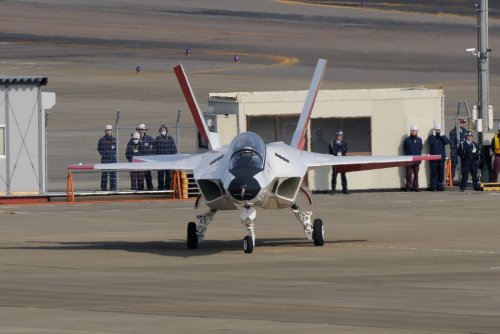 4.jpg475.5 KB · Views: 923
4.jpg475.5 KB · Views: 923 -
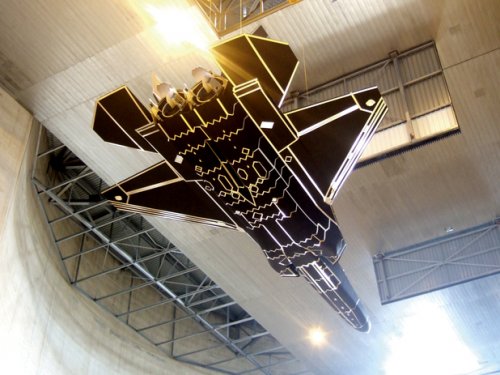 2.jpg404.2 KB · Views: 964
2.jpg404.2 KB · Views: 964 -
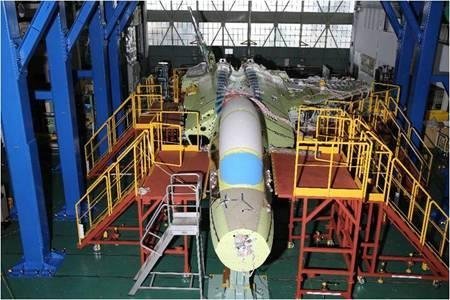 1.jpg39.8 KB · Views: 973
1.jpg39.8 KB · Views: 973
blackkite
Don't laugh, don't cry, don't even curse, but.....
- Joined
- 31 May 2007
- Messages
- 8,819
- Reaction score
- 7,718
blackkite
Don't laugh, don't cry, don't even curse, but.....
- Joined
- 31 May 2007
- Messages
- 8,819
- Reaction score
- 7,718
Hi!
Source : Japanese Stealth Fighter, ISBN978-4-8022-0178-0
Landing gear : from T-2, Cockpit(Wind shield, Canopy,Seat(Single!!)) : from T-4, Arresting hook : from T-2
熱交換器排出口 : Heat exchanger exhaust nozzle
Source : Japanese Stealth Fighter, ISBN978-4-8022-0178-0
Landing gear : from T-2, Cockpit(Wind shield, Canopy,Seat(Single!!)) : from T-4, Arresting hook : from T-2
熱交換器排出口 : Heat exchanger exhaust nozzle
Attachments
blackkite
Don't laugh, don't cry, don't even curse, but.....
- Joined
- 31 May 2007
- Messages
- 8,819
- Reaction score
- 7,718
Indeed!!Trident said:One thing that strikes me about the X-2 is the chord of those TE flaperons - massive! Big tailerons have been the norm for a while, but those flaperons are huge.
フラッペロン : Flaperon, スタビレーター : Stabilator
blackkite
Don't laugh, don't cry, don't even curse, but.....
- Joined
- 31 May 2007
- Messages
- 8,819
- Reaction score
- 7,718
- Joined
- 9 October 2009
- Messages
- 21,976
- Reaction score
- 13,638
It would appear that there are those within the Japanese government that are trying to push a cheaper 'conventional' design as an alternative to the Shinshin derived F-3 design: http://www.reuters.com/article/us-aerospace-japan-idUSKCN12A2M4
The strongest supporters of a cheaper conventional aircraft are officials close to Prime Minister Shinzo Abe, said the sources. Abe's government has reversed a decade of defense cuts with spending reaching record levels. However, those increases are a fraction of the extra China is spending every year on its military.
A cheaper fighter program would free up funding for other purchases and a lower cost jet that other nations could afford opens up the prospect of overseas sales that would further lower unit costs for Japan's Self Defence Force.
Pushing for a more advanced fighter are defense ministry bureaucrats and local companies seeking to secure jobs, underpin defense industry supply chains and compensate for business lost to U.S. defense industry suppliers.
Proponents aim to build a jet more advanced than the U.S. Lockheed's F-22 Raptor stealth fighter, said another of the industry sources.
- Joined
- 16 January 2015
- Messages
- 791
- Reaction score
- 3,602
Grey Havoc said:It would appear that there are those within the Japanese government that are trying to push a cheaper 'conventional' design as an alternative to the Shinshin derived F-3 design: http://www.reuters.com/article/us-aerospace-japan-idUSKCN12A2M4
The strongest supporters of a cheaper conventional aircraft are officials close to Prime Minister Shinzo Abe, said the sources. Abe's government has reversed a decade of defense cuts with spending reaching record levels. However, those increases are a fraction of the extra China is spending every year on its military.
A cheaper fighter program would free up funding for other purchases and a lower cost jet that other nations could afford opens up the prospect of overseas sales that would further lower unit costs for Japan's Self Defence Force.
Pushing for a more advanced fighter are defense ministry bureaucrats and local companies seeking to secure jobs, underpin defense industry supply chains and compensate for business lost to U.S. defense industry suppliers.
Proponents aim to build a jet more advanced than the U.S. Lockheed's F-22 Raptor stealth fighter, said another of the industry sources.
Can't really understand what the reasoning behind this could be.
As far as I remember the ATD-X program was born once it was clear to Japan that the US weren't going to sell them the F-22 and that they had to settle with the F-35 as a successor for their current fleet.
Moreover:
1 - I don't think there's market for a cheaper fighter. Super Hornets, Typhoons, Rafales and Gripens are filling that spot when it comes to buyers that are not getting equipped with Chinese or Russian products.
2 - if they're talking about an aircraft cheaper than the F-22 but not as cheap as a Gripen, there's the F-35. If the plan is to make something as good as a F-35 and sell it worldwide, good luck with that.
A good way they could pursue to share the burden of the costs, could be partnering up with other nations that cannot get the F-22 and could be interested in getting a platform with similar performances, the UK just for one.
CiTrus90 said:Grey Havoc said:It would appear that there are those within the Japanese government that are trying to push a cheaper 'conventional' design as an alternative to the Shinshin derived F-3 design: http://www.reuters.com/article/us-aerospace-japan-idUSKCN12A2M4
The strongest supporters of a cheaper conventional aircraft are officials close to Prime Minister Shinzo Abe, said the sources. Abe's government has reversed a decade of defense cuts with spending reaching record levels. However, those increases are a fraction of the extra China is spending every year on its military.
A cheaper fighter program would free up funding for other purchases and a lower cost jet that other nations could afford opens up the prospect of overseas sales that would further lower unit costs for Japan's Self Defence Force.
Pushing for a more advanced fighter are defense ministry bureaucrats and local companies seeking to secure jobs, underpin defense industry supply chains and compensate for business lost to U.S. defense industry suppliers.
Proponents aim to build a jet more advanced than the U.S. Lockheed's F-22 Raptor stealth fighter, said another of the industry sources.
Can't really understand what the reasoning behind this could be.
As far as I remember the ATD-X program was born once it was clear to Japan that the US weren't going to sell them the F-22 and that they had to settle with the F-35 as a successor for their current fleet.
Moreover:
1 - I don't think there's market for a cheaper fighter. Super Hornets, Typhoons, Rafales and Gripens are filling that spot when it comes to buyers that are not getting equipped with Chinese or Russian products.
2 - if they're talking about an aircraft cheaper than the F-22 but not as cheap as a Gripen, there's the F-35. If the plan is to make something as good as a F-35 and sell it worldwide, good luck with that.
A good way they could pursue to share the burden of the costs, could be partnering up with other nations that cannot get the F-22 and could be interested in getting a platform with similar performances, the UK just for one.
I think one of the key drivers behind this reasoning is possibly an implicit understanding that developing a full standard 5th generation stealth fighter in the class of F-22 or F-35, and then likely only purchased in relatively limited numbers by the JASDF (think F-2 production run) might be too costly, even despite their slightly expanding military budget.
The idea of potentially selling a cheaper, more conventional aircraft is a bit of a doubtful, and I wouldn't be surprised if this is an argument being pushed to by the conventional/cheaper group to convince politicians or bureaucrats who don't know any better, even if the real world likelihood of success in future is very low.
- Joined
- 2 August 2006
- Messages
- 3,256
- Reaction score
- 1,528
By partnering with LM they're hoping to save development costs by using LM's expertise. Otherwise, they're going to have to spend even more money just to learn what many western companies already know. Also, it would be optimized for the JASDF mission. I see this as LM helping in the same way they helped with the F-2. The problems I see, though, are how much could LM actually share with them in terms of LO tech? I would guess anything at the level of stealth the F-35 has since they're already building it.
- Joined
- 3 June 2011
- Messages
- 18,338
- Reaction score
- 12,240
http://www.defense-aerospace.com/articles-view/release/3/177989/lockheed-proposes-stealth-fighter-project-with-mitsubishi-heavy.html
They also mention Boeing. I'm surprised Northrop Grumman hasn't thrown their hat in the ring. I'd think they'd have a better chance than Boeing.
They also mention Boeing. I'm surprised Northrop Grumman hasn't thrown their hat in the ring. I'd think they'd have a better chance than Boeing.
Articles like these keep mentioning that F-2 will be replaced. But won't the F-15 be replaced in reality? Japanese next gen plane requirement is for an air superiority fighter, as far as i know. Plus F-15 might be longer in the tooth than f-2.
- Joined
- 16 January 2015
- Messages
- 791
- Reaction score
- 3,602
totoro said:Articles like these keep mentioning that F-2 will be replaced. But won't the F-15 be replaced in reality? Japanese next gen plane requirement is for an air superiority fighter, as far as i know. Plus F-15 might be longer in the tooth than f-2.
Agreed. F-15Js are, at least, 10 to 15 years older than the F-2s and will need to be replaced around the 2028-2030 timeframe.
What JASDF desires, moreover, is possibly a twin engined aircraft with supercruise capability and stealth. At the moment, the only aircraft fitting that bill is the F-22, which is clearly out of the question for them.
So the options are:
1 - they go ahead domestically with the F-XX program and develop their own 5th generation fighter aircraft;
2 - they partner up with a US producer and develop a 5th generation fighter aircraft, in a similar way to what happend with the F-2 program;
3 - they partner up with a foreign producer, non-US based, and develop a 5th generation fighter aircraft;
4 - they partner up with a US producer and develop a 6th generation fighter aircraft;
5 - they shelf the F-XX program and develop a 4/4.5th generation fighter aircraft, either domestically or not.
Option 2 automatically excludes the possibility of marketing said aircraft, as it would constitute a rival to the F-35.
Option 4 has been/is being considered, IIRC, by both countries.
Option 5 is the least desirable one, as Japan's neighbours will have stealth aircraft in that timeframe.
I do not consider viable the possibility of developing a 6th generation fighter with a non US based producer.
In my opinion, option 3 in a partnership with a European producer (BAE, EADS, SAAB) would seem the most logical way to solve this issue (keeping costs down, both by sharing development costs with other nations and with the added possibility of marketing the aircraft globally).
- Joined
- 3 June 2011
- Messages
- 18,338
- Reaction score
- 12,240
totoro said:Articles like these keep mentioning that F-2 will be replaced. But won't the F-15 be replaced in reality? Japanese next gen plane requirement is for an air superiority fighter, as far as i know. Plus F-15 might be longer in the tooth than f-2.
Nope. They're keeping their F-15s around for a long time.
I find it hard to believe Japan would be keeping their f15 significantly longer than usaf keeps theirs. by 2030, youngest of usaf's f15c will be 45 years old. And average of 200ish survivors will be perhaps closer to 50 years. Japan's fleet was produced from 1981 to 1997, meaning their average f15c is going to be 42 years old in 2030. With oldest ones approaching 50 years old. So Japan will need to start replacing them from 2030 onwards. Which pretty much suits a realistic, drawn out development cycle of a domestic plane. Demonstrator flying today, real programe commencing within a few years, first prototype flight in early 2020s, 7-8 year development/testing cycle like most of today's planes and entry into service around 2030.
Now, maybe f-2 will need replacement around the same timeframe as well, who knows. But f-2 are more of a striker/fighter combo than a pure air superiority fighter. So f-2 might be replaced by additional f-35 (since japan will already operate f-35). That way future japanese fleet would be served by two types, instead of current 3.
Now, maybe f-2 will need replacement around the same timeframe as well, who knows. But f-2 are more of a striker/fighter combo than a pure air superiority fighter. So f-2 might be replaced by additional f-35 (since japan will already operate f-35). That way future japanese fleet would be served by two types, instead of current 3.
- Joined
- 2 August 2006
- Messages
- 3,256
- Reaction score
- 1,528
CiTrus90 said:Agreed. F-15Js are, at least, 10 to 15 years older than the F-2s and will need to be replaced around the 2028-2030 timeframe.
What JASDF desires, moreover, is possibly a twin engined aircraft with supercruise capability and stealth. At the moment, the only aircraft fitting that bill is the F-22, which is clearly out of the question for them.
So the options are:
1 - they go ahead domestically with the F-XX program and develop their own 5th generation fighter aircraft;
2 - they partner up with a US producer and develop a 5th generation fighter aircraft, in a similar way to what happend with the F-2 program;
3 - they partner up with a foreign producer, non-US based, and develop a 5th generation fighter aircraft;
4 - they partner up with a US producer and develop a 6th generation fighter aircraft;
5 - they shelf the F-XX program and develop a 4/4.5th generation fighter aircraft, either domestically or not.
Option 2 automatically excludes the possibility of marketing said aircraft, as it would constitute a rival to the F-35.
Option 4 has been/is being considered, IIRC, by both countries.
Option 5 is the least desirable one, as Japan's neighbours will have stealth aircraft in that timeframe.
I do not consider viable the possibility of developing a 6th generation fighter with a non US based producer.
In my opinion, option 3 in a partnership with a European producer (BAE, EADS, SAAB) would seem the most logical way to solve this issue (keeping costs down, both by sharing development costs with other nations and with the added possibility of marketing the aircraft globally).
Actually, they aren't looking that hard at supercruising any more, as their studies have shown that endurance is more important. They're looking more at the ability to loiter with a deep magazine of missiles. My guess is, they may be interested in some of the upgrades Boeing is offering to the U.S. F-15 fleet in being able to mount many more A2A missiles on the F-15's to use them as stand-off launchers for F-22s and F-35s (F-3's and F-35s for the JASDF).
- Joined
- 16 January 2015
- Messages
- 791
- Reaction score
- 3,602
Sundog said:Actually, they aren't looking that hard at supercruising any more, as their studies have shown that endurance is more important. They're looking more at the ability to loiter with a deep magazine of missiles. My guess is, they may be interested in some of the upgrades Boeing is offering to the U.S. F-15 fleet in being able to mount many more A2A missiles on the F-15's to use them as stand-off launchers for F-22s and F-35s (F-3's and F-35s for the JASDF).
Yes, they're interested in upgunning their F-15Js and bringing the number of missiles they can carry up to 16:
http://asia.nikkei.com/Politics-Economy/Policy-Politics/Japan-eyes-fiercer-fighter-jets-to-counter-China?page=1
The hunter-killer tactic, with F-35s picking targets and the F-15s playing quarterbacks, is good, but I'm not that much confident that only 42 F-35s can keep at bay aircraft like the J-20 without the latter inflicting serious losses.
Either, they buy more F-35s (and I'm pretty sure that will definitely happen at some point in the future) and their fighter fleet will (eventually, once F-15Js and F-2s get phased out) be entirely based on them, or they produce their own 5th generation fighter to go along with them.
If they go ahead with the F-3 program and intend to market it internationally too, to save on costs, I don't see any possibilty for them of doing so while in partnership with a US producer (be it LM, NG or Boeing - as it would be a competitor to the F-35).
This is why I'm saying that, if they want to market the plane to save on development costs, they either have to partner up with other countries to build their own 5th generation fighter or have to go ahead domestically (with more costs).
Or, worse option of all the possibile ones, they can give up on a domestic 5th generation aircraft entirely.
- Joined
- 29 September 2006
- Messages
- 1,794
- Reaction score
- 1,360
CiTrus90 said:The hunter-killer tactic, with F-35s picking targets and the F-15s playing quarterbacks, is good, but I'm not that much confident that only 42 F-35s can keep at bay aircraft like the J-20 without the latter inflicting serious losses.
Japan will, unless there is a major change in its defence posture, be operating in home ground. Japanese ground, air and naval assets will be operating to back each other up. China, in that scenario, would be the one making forays into enemy territory.
starviking said:CiTrus90 said:The hunter-killer tactic, with F-35s picking targets and the F-15s playing quarterbacks, is good, but I'm not that much confident that only 42 F-35s can keep at bay aircraft like the J-20 without the latter inflicting serious losses.
Japan will, unless there is a major change in its defence posture, be operating in home ground. Japanese ground, air and naval assets will be operating to back each other up. China, in that scenario, would be the one making forays into enemy territory.
I think the most likely site of potential conflict between the two countries in the future would be in the ECS around the disputed islands, so I think it would be a theatre where both sides would be relatively even footing.
I'm sure some JSDF bases in Okinawa could be quite relevant for an ECS situation, but even then those islands are about equidistant from the disputed islands as the Chinese mainland coast is, so I think the assets each side can bring to bear will mostly be air and naval in nature, possibly also with long range conventional missiles as well.
If China was trying to invade the Japanese home islands for whatever nonsensical reason then Japanese ground capabilities and ground based air defences would obviously come into play, but the chances of that happening are so low it's not worth entertaining.
marauder2048
"I should really just relax"
- Joined
- 19 November 2013
- Messages
- 3,157
- Reaction score
- 926
Blitzo said:If China was trying to invade the Japanese home islands for whatever nonsensical reason then Japanese ground capabilities and ground based air defences would obviously come into play, but the chances of that happening are so low it's not worth entertaining.
But could Japanese military planners rule out airborne or amphibious operations against the home islands to such an extent
that it would obviate the need for holding certain air and naval units in reserve as a counter? That's less clear (to me at least).
marauder2048 said:Blitzo said:If China was trying to invade the Japanese home islands for whatever nonsensical reason then Japanese ground capabilities and ground based air defences would obviously come into play, but the chances of that happening are so low it's not worth entertaining.
But could Japanese military planners rule out airborne or amphibious operations against the home islands to such an extent
that it would obviate the need for holding certain air and naval units in reserve as a counter? That's less clear (to me at least).
Oh I'm sure JSDF planners would have considered it because it's their job to consider even unlikely scenarios; I'm sure Chinese military planners have probably considered a JSDF amphibious invasion of China as well lol.
However, for the purpose of the previous discussion of where F-3 and overall JASDF would need to be expected to perform in, the most likely scenario is probably one where they will be operating in an environment where they will fight in relatively even footing against the PLA, where they would not have the benefit of many ground based assets as an advantage like in a home islands invasion... so unless the JASDF is going to orientate its missions to only defend against an invasion of the home islands, and not partake in any operations in their peripheral waters and airspace, then I imagine their requirements for F-3 and the JADSF of the future will have to be one where they have to discount ground based assets like IADS, for the sake of being prudent.
- Joined
- 21 April 2009
- Messages
- 13,759
- Reaction score
- 7,698
http://aviationweek.com/combat-aircraft/japan-refines-design-indigenous-future-fighter?NL=AW-19&Issue=AW-19_20171123_AW-19_854&sfvc4enews=42&cl=article_6&utm_rid=CPEN1000000230026&utm_campaign=12752&utm_medium=email&elq2=f457d073366a4389a4461ffb783a4c77
- Joined
- 9 October 2009
- Messages
- 21,976
- Reaction score
- 13,638
There has been some speculation over at Tank-Net that the premature ending of the X-2 flight test program was directly related to the Kobe Steel scandal (though it looks like the Mitsubishi group now has it's own in-house scandal to deal with that could also be possibly related). It should be noted though that the flight test program's curtailment could alternatively be down to the current state of affairs within the Acquisition Technology and Logistics Agency; it would seem that the Ministry for Finance may have all but annexed the agency, with predictable results.
- Joined
- 6 November 2010
- Messages
- 5,263
- Reaction score
- 5,514
From Reuters: https://uk.reuters.com/article/uk-japan-defence-lockheed-exclusive/exclusive-lockheed-martin-to-propose-stealthy-hybrid-of-f-22-and-f-35-for-japan-sources-idUKKBN1HR0MC
Lockheed Martin to propose stealthy hybrid of F-22 and F-35 for Japan
sources Tim Kelly, Nobuhiro Kubo
4 MIN READ
TOKYO (Reuters) - U.S. defence contractor Lockheed Martin Corp (LMT.N) plans to offer Japan a stealth fighter design based on its export-banned F-22 Raptor and advanced F-35 Lightning II aircraft, two sources said.
Lockheed has discussed the idea with Japanese defence ministry officials and will make a formal proposal in response to a Japanese request for information (RFI) after it receives permission from the U.S. government to offer the sensitive military technology, said the sources, who have direct knowledge of the proposal.
The decision on whether to release parts of the highly classified aircraft designs and software to help Japan stay ahead of Chinese advances will test President Donald Trump’s promise to overhaul his country’s arms export policy.
The proposed aircraft “would combine the F-22 and F-35 and could be superior to both of them,” said one of the sources.
Japan, which is already buying the radar-evading F-35 to modernise its inventory, also wants to introduce a separate air superiority fighter in the decade starting 2030 to deter intrusions into its airspace by Chinese and Russian jets.
The country’s air force currently flies the F-15J, based on the Boeing F-15; and the F-2, based on the Lockheed Martin F-16. Both designs are decades old.
Japan’s ambition to build its own stealth fighter was in part spurred by Washington’s refusal a decade ago to sell it the twin-engined F-22, which is still considered the world’s best air superiority fighter.
Although the Japanese stealth aircraft programme, dubbed the F-3, was conceived as a domestic effort estimated to cost around $40 billion, Tokyo has recently sought international collaboration in a bid to share the expense and gain access to technology it would otherwise have to develop from scratch.
Any aircraft built with international partners must have Japanese-designed engines and radar, however, and feature other components made locally, the other source said. Mitsubishi Heavy Industries (7011.T) tested a prototype stealth jet in 2016 that cost the Japanese government $350 million to develop.
“We are considering domestic development, joint development and the possibility of improving existing aircraft performance, but we have not yet come to any decision,” a Ministry of Defense spokesman said on Friday.
The Japanese government in March issued a third RFI for the F-3 to foreign defence companies and sent a separate document outlining its requirements in more detail to the British and United States governments.
In addition to a proposal from Lockheed, Japan is hoping for responses from Boeing Co (BA.N), which makes the F/A-18 Super Hornet multirole fighter, and BAE Systems Plc (BAES.L), which is part of the consortium that built the Eurofighter Typhoon high-altitude interceptor.
“We look forward to exploring options for Japan’s F-2 replacement fighter in cooperation with both the Japanese and U.S. governments. Our leadership and experience in 5th generation aircraft can be leveraged to cost-effectively provide capabilities to meet Japan’s future security needs,” a Lockheed Martin spokeswoman said.
- Joined
- 3 June 2011
- Messages
- 18,338
- Reaction score
- 12,240
Arjen said:From Reuters: https://uk.reuters.com/article/uk-japan-defence-lockheed-exclusive/exclusive-lockheed-martin-to-propose-stealthy-hybrid-of-f-22-and-f-35-for-japan-sources-idUKKBN1HR0MC
Lockheed Martin to propose stealthy hybrid of F-22 and F-35 for Japan
sources Tim Kelly, Nobuhiro Kubo
4 MIN READ
TOKYO (Reuters) - U.S. defence contractor Lockheed Martin Corp (LMT.N) plans to offer Japan a stealth fighter design based on its export-banned F-22 Raptor and advanced F-35 Lightning II aircraft, two sources said.
Lockheed has discussed the idea with Japanese defence ministry officials and will make a formal proposal in response to a Japanese request for information (RFI) after it receives permission from the U.S. government to offer the sensitive military technology, said the sources, who have direct knowledge of the proposal.
The decision on whether to release parts of the highly classified aircraft designs and software to help Japan stay ahead of Chinese advances will test President Donald Trump’s promise to overhaul his country’s arms export policy.
The proposed aircraft “would combine the F-22 and F-35 and could be superior to both of them,” said one of the sources.
Japan, which is already buying the radar-evading F-35 to modernise its inventory, also wants to introduce a separate air superiority fighter in the decade starting 2030 to deter intrusions into its airspace by Chinese and Russian jets.
The country’s air force currently flies the F-15J, based on the Boeing F-15; and the F-2, based on the Lockheed Martin F-16. Both designs are decades old.
Japan’s ambition to build its own stealth fighter was in part spurred by Washington’s refusal a decade ago to sell it the twin-engined F-22, which is still considered the world’s best air superiority fighter.
Although the Japanese stealth aircraft programme, dubbed the F-3, was conceived as a domestic effort estimated to cost around $40 billion, Tokyo has recently sought international collaboration in a bid to share the expense and gain access to technology it would otherwise have to develop from scratch.
Any aircraft built with international partners must have Japanese-designed engines and radar, however, and feature other components made locally, the other source said. Mitsubishi Heavy Industries (7011.T) tested a prototype stealth jet in 2016 that cost the Japanese government $350 million to develop.
“We are considering domestic development, joint development and the possibility of improving existing aircraft performance, but we have not yet come to any decision,” a Ministry of Defense spokesman said on Friday.
The Japanese government in March issued a third RFI for the F-3 to foreign defence companies and sent a separate document outlining its requirements in more detail to the British and United States governments.
In addition to a proposal from Lockheed, Japan is hoping for responses from Boeing Co (BA.N), which makes the F/A-18 Super Hornet multirole fighter, and BAE Systems Plc (BAES.L), which is part of the consortium that built the Eurofighter Typhoon high-altitude interceptor.
“We look forward to exploring options for Japan’s F-2 replacement fighter in cooperation with both the Japanese and U.S. governments. Our leadership and experience in 5th generation aircraft can be leveraged to cost-effectively provide capabilities to meet Japan’s future security needs,” a Lockheed Martin spokeswoman said.
Was just going to post this. Might be worth its own topic.
- Joined
- 6 November 2010
- Messages
- 5,263
- Reaction score
- 5,514
There is another post here in the F-22 thread: https://www.secretprojects.co.uk/forum/index.php/topic,4505.msg328171.html#msg328171
I posted in this thread, because I'm guessing if any part of it is going to be done, it will result in something that's neither F-22 nor F-35. And possibly a follow-on to ATD-X/X-2. I don't expect anything of it, to be honest.
I posted in this thread, because I'm guessing if any part of it is going to be done, it will result in something that's neither F-22 nor F-35. And possibly a follow-on to ATD-X/X-2. I don't expect anything of it, to be honest.
- Joined
- 11 February 2010
- Messages
- 1,650
- Reaction score
- 2,703
I take it as.. Lockheed will support Japan in their X-2/F-3 program.
blackkite
Don't laugh, don't cry, don't even curse, but.....
- Joined
- 31 May 2007
- Messages
- 8,819
- Reaction score
- 7,718
Similar threads
-
Strange model fighter jet in Mitsubishi Museum
- Started by Tiger2
- Replies: 2
-
TRDI/Mitsubishi XSSM-1 surface-to-ship missile
- Started by Stargazer
- Replies: 1
-
Airborne Fleet Air Defense System - MSDF
- Started by Grey Havoc
- Replies: 6
-
Japan's FS-X (Fighter Support-Experimental) Program
- Started by Sentinel Chicken
- Replies: 82
-
GSDF Maneuver Combat Vehicle (formerly known as the Mobile Combat Vehicle)
- Started by Grey Havoc
- Replies: 12

